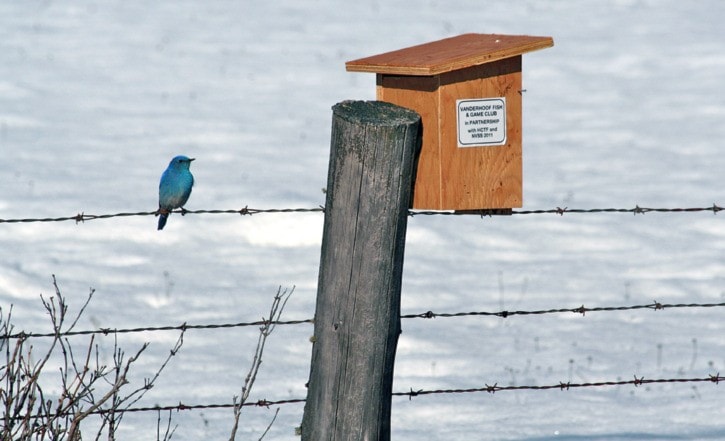The Vanderhoof Fish and Game Club has partnered with UNBC on a project that will bring 250 new blue bird nest boxes into the community this spring.
The partnership will enhance a conservation project in Vanderhoof which originally started last year, and involved the installation of 200 duck and 40 raptor boxes around the agricultural community.
The project is being funded by a grant from the Habitat Conservation Trust Foundation.
After project leader, Wayne Salewski, read a story in a newspaper that Dr. Russ Dawson at UNBC was receiving a grant for a study that would track migrating blue birds, he contacted the professor to suggest a partnership between the two projects.
Dr. Russ Dawson a professor of the Ecosystem Science and Management (Biology) Program at UNBC currently uses six study areas in Canada for his program, four around Prince George, one south of Williams Lake specifically for bluebirds and one in northern Saskatchewan for the study of falcons. He says having an additional study area in Vanderhoof will benefit the study of migrating blue birds by giving it more depth.
“Our study area near Williams Lake is along the Fraser River near the Gang Ranch, an area that is extremely arid.
“Studying blue birds in the Vanderhoof area, where the ecosystem and climate is very different, will help us understand how variation in things like climate and food supply affect the birds, and so it is a very nice contrast,” he said.
“But even without the research, I think most people find aesthetic value in having mountain bluebirds around,” he added.
Salewski says the original project came about as a reaction to the pine beetle epidemic.
“The original intent was to help replace lost nesting opportunities for cavity nesters as a result of the mountain pine beetle epidemic,” said Salewski.
He added that the partnership will be good for the area because the study will see students traveling to and from the area and so will be good for the local economy, and the study also gives the bird boxes another use.
Dr. Dawsons research program is based around trying to understand what influences reproductive success in birds and what drives changes in population sizes.
“Some of the things we are interested in knowing more about is how factors such as food supply and climate influence reproduction.”
“We need to understand how birds will respond, both positively and negatively, to such changes,” he said.
In order to gather the research needed for the study, students will be monitoring the breeding biology of the birds that use the nest boxes.
Leg bands will be placed on all of the young birds to trace survival rates. Adults birds will have an additional colored band.
“For adult bluebirds, in addition to putting a regular numbered leg band on them, we also would put colored bands on their legs with unique combinations.
“This allows us to keep track of adults from year to year, and we can just read their color combinations with binoculars and don’t have to catch them year after year,” said Dr. Dawson.
Each of the bird boxes has been given GPS coordinates so that UNBC students will be able to easily locate them.
The majority of boxes for the partnered projects were made by handicapped students in Vanderhoof.
“We are proud of our relationship with the woodworking classes of Rock Allred from the Nechako Valley Senior Secondary high school here in Vanderhoof which combined our project with handicapped classes to construct the majority of the boxes for this project,” said Salewski.
